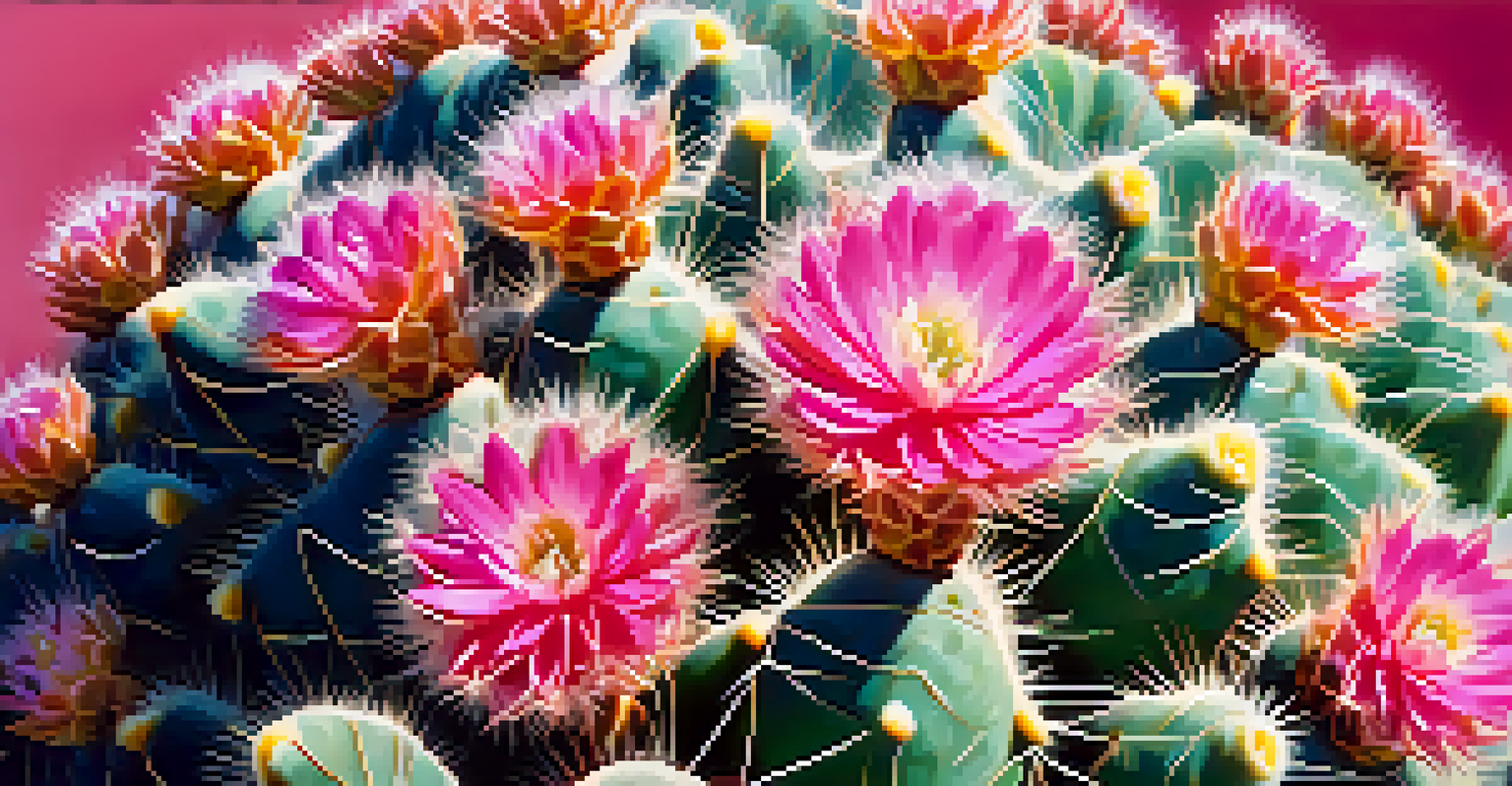The Role of Peyote in Healing Circles and Community Bonds

Understanding Peyote: A Sacred Plant
Peyote, a small cactus native to the southwestern United States and Mexico, has been used for centuries by various Indigenous cultures. This plant is not just a psychedelic substance; it holds deep spiritual significance in many healing practices. The psychoactive component, mescaline, is believed to facilitate profound introspection and connection with the divine.
The plant is a teacher, a guide that shows us the way to heal ourselves and our communities.
For many, Peyote represents a bridge between the physical and spiritual realms. It is often consumed in ceremonial settings, where its effects can lead participants to explore their inner thoughts and emotions. Through this exploration, individuals can gain insights that promote healing and personal growth.
By understanding Peyote's role in these traditions, we can appreciate why it is viewed as a catalyst for community bonding. The shared experience during ceremonies fosters a sense of unity, encouraging participants to support each other's healing journeys.
Healing Circles: A Sacred Space for Connection
Healing circles are gathering spaces where individuals come together to share their experiences and support one another. These circles often incorporate the use of Peyote, creating an environment that nurtures vulnerability and openness. Participants feel safe to express their struggles, fears, and triumphs.

The power of a healing circle lies in its ability to dissolve barriers between individuals. As participants share their stories, they often find common ground, leading to a profound sense of belonging. This communal aspect is vital, as it reinforces the idea that no one is alone in their journey.
Peyote as a Sacred Healing Tool
Peyote serves as a powerful catalyst for personal and communal healing through its use in ceremonial practices.
Moreover, the presence of Peyote in these circles can enhance the emotional and spiritual connections. Participants often report feeling a heightened sense of empathy and understanding, making the healing process more impactful and transformative. It’s this shared experience that strengthens bonds among community members.
Peyote and Its Role in Indigenous Traditions
For many Indigenous communities, Peyote is not just a substance but a sacred teacher. It is often used in rituals and ceremonies that are deeply embedded in their cultural heritage. These traditions emphasize respect for nature and the interconnectedness of all beings.
Healing is not just an individual journey but a communal experience that connects us all.
The use of Peyote in these rituals is typically guided by experienced leaders who ensure that participants approach the experience with reverence. This guidance is essential, as it helps maintain the integrity of the practice and fosters a sense of responsibility among participants.
By participating in these traditional practices, individuals can reconnect with their cultural roots and foster a deeper appreciation for their community. This cultural aspect is crucial, as it helps to preserve the knowledge and values that have been passed down through generations.
The Therapeutic Effects of Peyote
Peyote’s psychoactive properties can lead to profound therapeutic effects, particularly in a communal setting. Many participants report experiencing emotional release, clarity, and a sense of peace during and after the experience. This can be especially beneficial for those dealing with trauma or mental health challenges.
Through guided ceremonies, individuals often confront difficult emotions and past experiences. Peyote facilitates this process by allowing participants to view their pain from a different perspective, leading to healing and acceptance. The shared support from the community further enhances these benefits.
Community Bonds Through Shared Journeys
Participating in Peyote ceremonies fosters deep connections among individuals, creating a supportive network that enhances healing.
Research suggests that such experiences can lead to lasting positive changes in one’s mental health and overall well-being. As participants integrate these insights into their daily lives, the impact of Peyote can extend far beyond the ceremony, fostering resilience and personal growth.
Building Community Bonds Through Shared Experiences
The act of participating in Peyote ceremonies fosters a unique bond among community members. As individuals navigate their personal journeys together, they strengthen their connections and create lasting friendships. This sense of camaraderie can be life-changing, especially for those who feel isolated.
Sharing vulnerabilities and personal stories in a safe environment helps to break down barriers. Participants often leave the circle feeling a renewed sense of purpose and belonging, knowing that they have allies in their journey. This shared experience cultivates a supportive network that extends beyond the ceremonial space.
Moreover, these community bonds can lead to collective healing. As individuals uplift and support one another, the entire community can thrive, fostering resilience and growth. This interconnectedness is a powerful aspect of the healing process, reminding us that we are stronger together.
Challenges and Considerations in Peyote Use
While Peyote has many potential benefits, it is essential to approach its use with caution and respect. Cultural appropriation and misuse can arise when individuals engage with Peyote without understanding its significance. Therefore, it is crucial to participate in such practices within the context of Indigenous traditions.
Moreover, not everyone is suited for Peyote use, particularly those with certain mental health conditions or those on specific medications. Individuals should consult with healthcare professionals and experienced practitioners before participating in ceremonies to ensure a safe experience.
Respecting Indigenous Traditions
Approaching Peyote with understanding and respect for its cultural significance is essential to preserving its role in healing practices.
Engaging with Peyote in a respectful manner also means acknowledging the rights and traditions of Indigenous communities. Supporting these communities and their practices can help preserve their cultural heritage while promoting responsible use of sacred plants.
The Future of Peyote in Healing Practices
As interest in alternative healing practices grows, Peyote's role in healing circles is gaining recognition beyond Indigenous communities. Many are beginning to appreciate its potential for personal and communal healing, sparking discussions on its place in modern therapeutic practices. This shift may help bridge cultural gaps and promote understanding of Indigenous traditions.
However, it is crucial to ensure that this recognition does not lead to exploitation. Protecting the cultural significance of Peyote and supporting Indigenous communities is paramount. This means advocating for responsible practices and acknowledging the wisdom of those who have used Peyote for generations.

Looking ahead, we can envision a future where Peyote is honored and used thoughtfully, contributing to both individual healing journeys and the strengthening of community ties. By embracing its role within a respectful framework, we can unlock the full potential of this sacred plant.